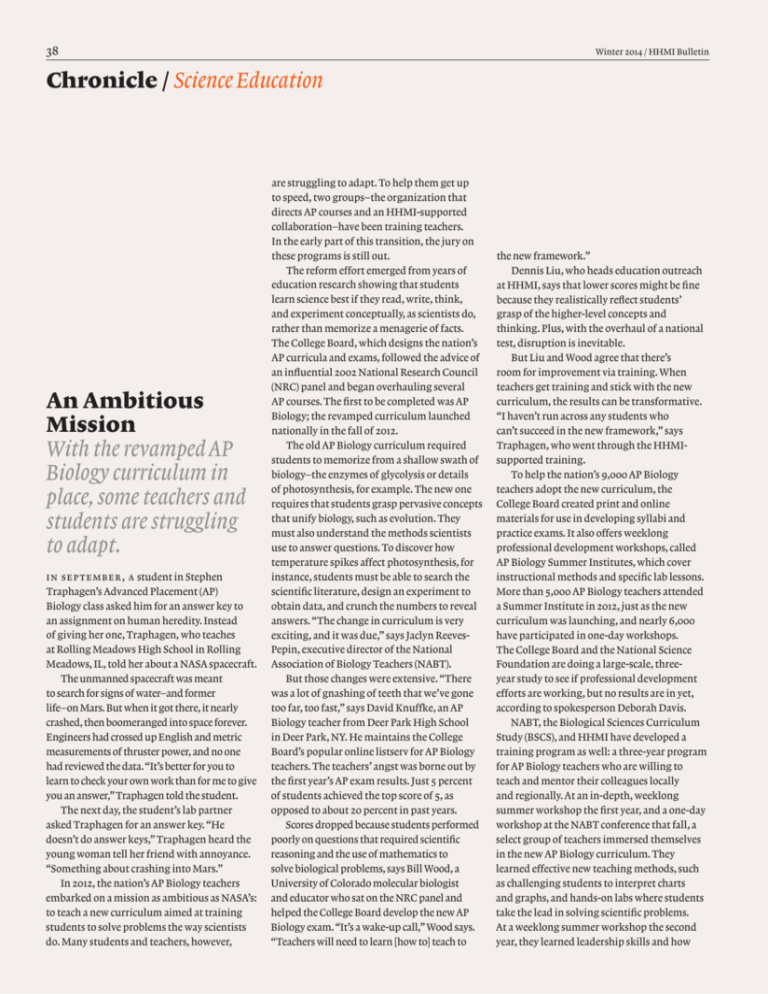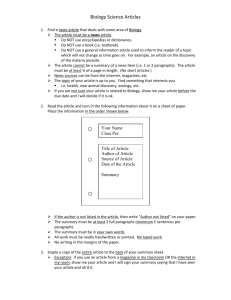PDF of this Story
advertisement

38 Winter 2014 / HHMI Bulletin Chronicle / Science Education An Ambitious Mission With the revamped AP Biology curriculum in place, some teachers and students are struggling to adapt. in september, a student in Stephen Traphagen’s Advanced Placement (AP) Biology class asked him for an answer key to an assignment on human heredity. Instead of giving her one, Traphagen, who teaches at Rolling Meadows High School in Rolling Meadows, IL, told her about a NASA spacecraft. The unmanned spacecraft was meant to search for signs of water—and former life—on Mars. But when it got there, it nearly crashed, then boomeranged into space forever. Engineers had crossed up English and metric measurements of thruster power, and no one had reviewed the data. “It’s better for you to learn to check your own work than for me to give you an answer,” Traphagen told the student. The next day, the student’s lab partner asked Traphagen for an answer key. “He doesn’t do answer keys,” Traphagen heard the young woman tell her friend with annoyance. “Something about crashing into Mars.” In 2012, the nation’s AP Biology teachers embarked on a mission as ambitious as NASA’s: to teach a new curriculum aimed at training students to solve problems the way scientists do. Many students and teachers, however, are struggling to adapt. To help them get up to speed, two groups—the organization that directs AP courses and an HHMI-supported collaboration—have been training teachers. In the early part of this transition, the jury on these programs is still out. The reform effort emerged from years of education research showing that students learn science best if they read, write, think, and experiment conceptually, as scientists do, rather than memorize a menagerie of facts. The College Board, which designs the nation’s AP curricula and exams, followed the advice of an influential 2002 National Research Council (NRC) panel and began overhauling several AP courses. The first to be completed was AP Biology; the revamped curriculum launched nationally in the fall of 2012. The old AP Biology curriculum required students to memorize from a shallow swath of biology—the enzymes of glycolysis or details of photosynthesis, for example. The new one requires that students grasp pervasive concepts that unify biology, such as evolution. They must also understand the methods scientists use to answer questions. To discover how temperature spikes affect photosynthesis, for instance, students must be able to search the scientific literature, design an experiment to obtain data, and crunch the numbers to reveal answers. “The change in curriculum is very exciting, and it was due,” says Jaclyn ReevesPepin, executive director of the National Association of Biology Teachers (NABT). But those changes were extensive. “There was a lot of gnashing of teeth that we’ve gone too far, too fast,” says David Knuffke, an AP Biology teacher from Deer Park High School in Deer Park, NY. He maintains the College Board’s popular online listserv for AP Biology teachers. The teachers’ angst was borne out by the first year’s AP exam results. Just 5 percent of students achieved the top score of 5, as opposed to about 20 percent in past years. Scores dropped because students performed poorly on questions that required scientific reasoning and the use of mathematics to solve biological problems, says Bill Wood, a University of Colorado molecular biologist and educator who sat on the NRC panel and helped the College Board develop the new AP Biology exam. “It’s a wake-up call,” Wood says. “Teachers will need to learn [how to] teach to the new framework.” Dennis Liu, who heads education outreach at HHMI, says that lower scores might be fine because they realistically reflect students’ grasp of the higher-level concepts and thinking. Plus, with the overhaul of a national test, disruption is inevitable. But Liu and Wood agree that there’s room for improvement via training. When teachers get training and stick with the new curriculum, the results can be transformative. “I haven’t run across any students who can’t succeed in the new framework,” says Traphagen, who went through the HHMIsupported training. To help the nation’s 9,000 AP Biology teachers adopt the new curriculum, the College Board created print and online materials for use in developing syllabi and practice exams. It also offers weeklong professional development workshops, called AP Biology Summer Institutes, which cover instructional methods and specific lab lessons. More than 5,000 AP Biology teachers attended a Summer Institute in 2012, just as the new curriculum was launching, and nearly 6,000 have participated in one-day workshops. The College Board and the National Science Foundation are doing a large-scale, threeyear study to see if professional development efforts are working, but no results are in yet, according to spokesperson Deborah Davis. NABT, the Biological Sciences Curriculum Study (BSCS), and HHMI have developed a training program as well: a three-year program for AP Biology teachers who are willing to teach and mentor their colleagues locally and regionally. At an in-depth, weeklong summer workshop the first year, and a one-day workshop at the NABT conference that fall, a select group of teachers immersed themselves in the new AP Biology curriculum. They learned effective new teaching methods, such as challenging students to interpret charts and graphs, and hands-on labs where students take the lead in solving scientific problems. At a weeklong summer workshop the second year, they learned leadership skills and how 39 HHMI Bulletin / Winter 2014 Wesley Bedrosian For more information on science education reform, see “Calling All Teachers” and “A 21st Century Cook Book,” HHMI Bulletin, November 2011. When teachers get training and stick with the new curriculum, the results can be transformative. to effectively teach their colleagues. NABT and BSCS also provide support through professional development workshops and regional networks of AP Biology teachers. Participants say the program, called the AP Biology Leadership Academy, empowers them to improve the teaching skills of their colleagues back home. When it comes to professional development, “the limiting factor most often is people’s sense of confidence, agency, and safety, and that’s only going to happen in small groups and face-to-face meetings,” says Traphagen, who completed the program and has trained 20 colleagues in the Chicago area and more than 200 in workshops at professional conferences. It won’t be easy to scale up in-depth training programs to a level sufficient to transform AP Biology classrooms nationwide. But it could happen if the newly trained teachers help spread the word about effective new teaching methods, says HHMI’s Liu. He hopes this will happen through teacher- led workshops held within regional networks. To date, the 46 teachers in the first training cohort have collectively given 21 workshops to more than 270 other teachers, and most reported that they were doing more informal mentoring, as well. In Ohio, Colorado, and Michigan, AP Biology teachers from the program have revitalized statewide networks of biology teachers, in part to support each other as they adapt to teaching the new curriculum. “We’ve learned that it’s hard, and these networks don’t gel on their own,” Liu says. “They need ongoing support.” HHMI is eager to provide it. “If we could get one regional network of teachers going, then I would call the overall model a success,” Liu says. Some, including Reeves-Pepin, are impatient for success and eager for large-scale change. “I appreciate the ripple effect,” says Reeves-Pepin, “but I want change—and the sooner the better.” —Dan Ferber






